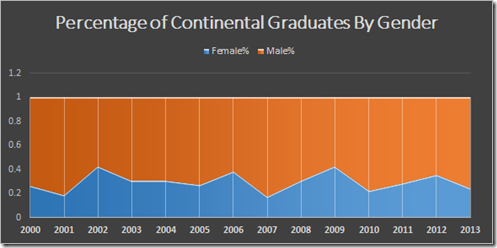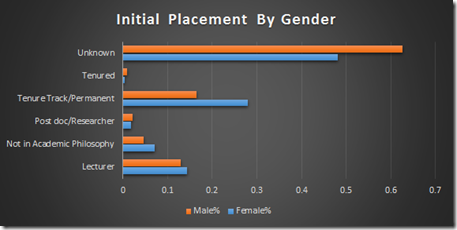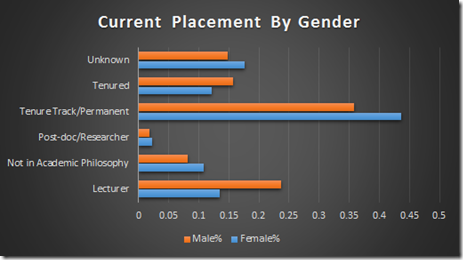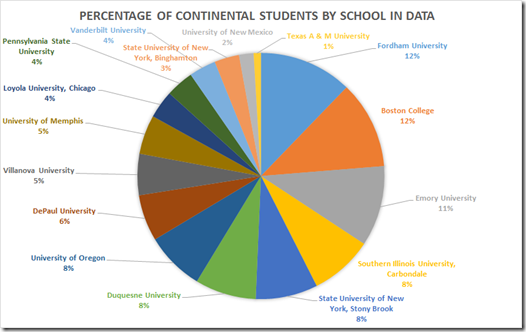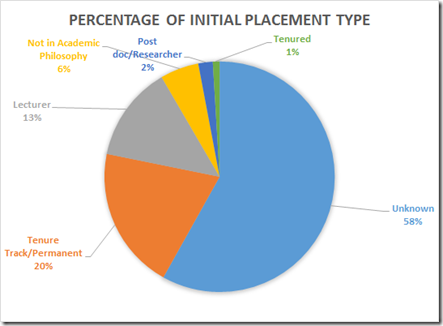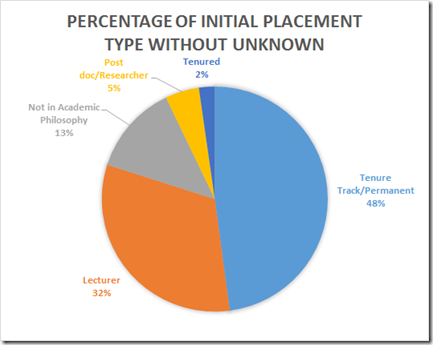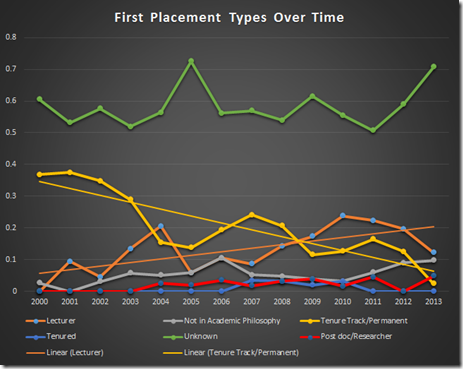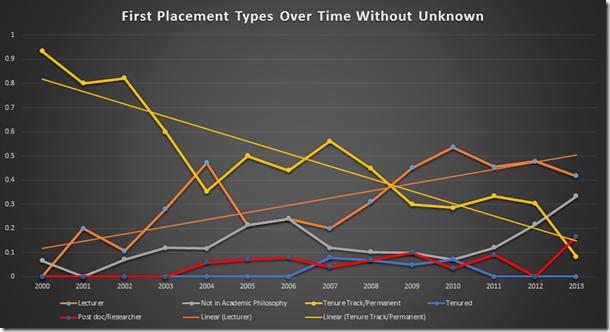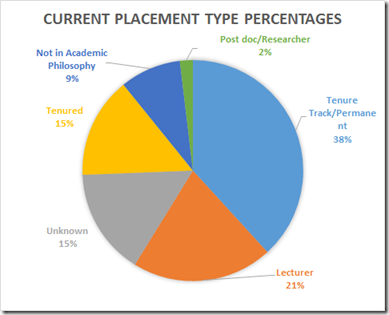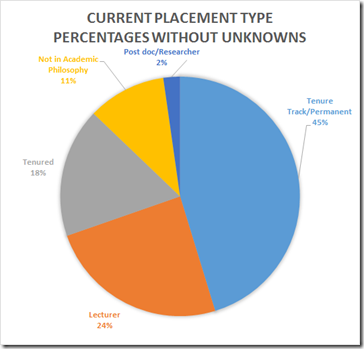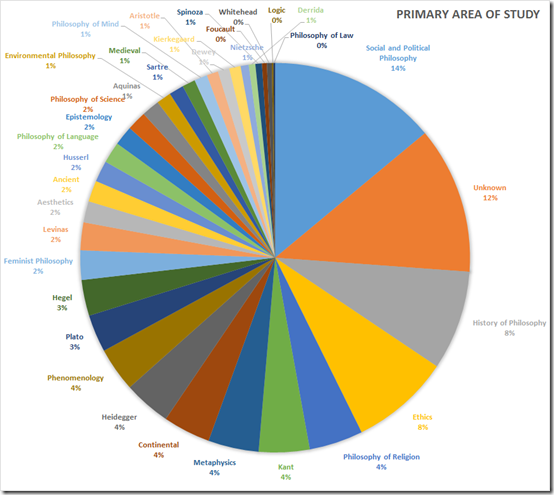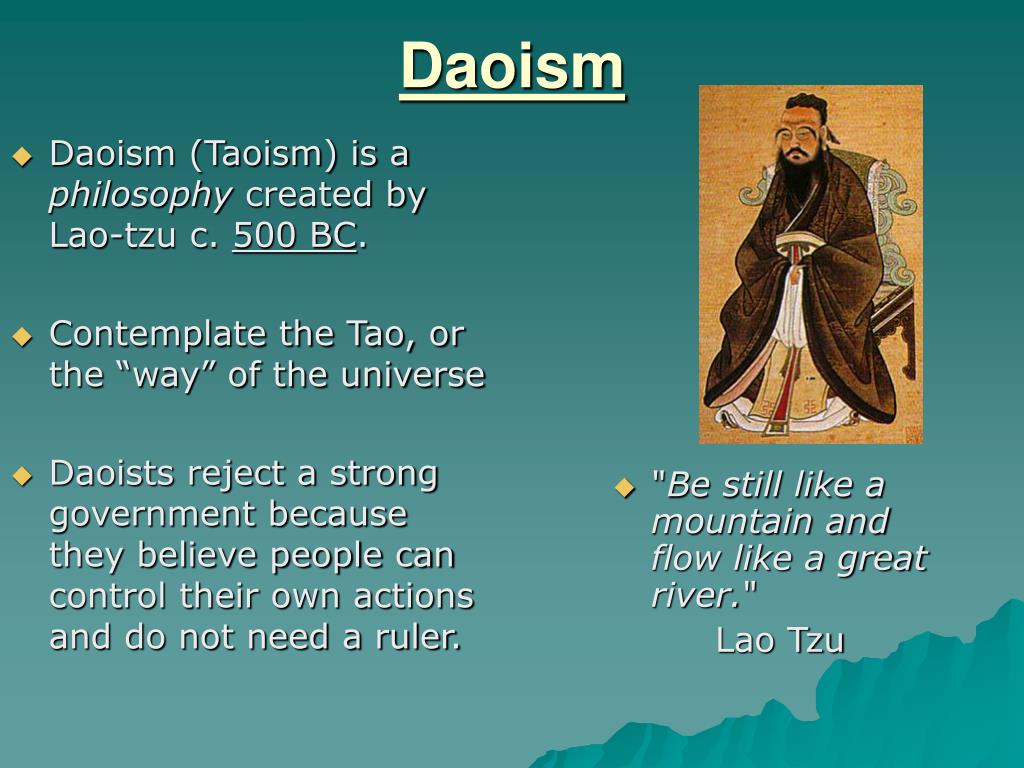This article is an attempt at an analysis of the placement records of most leading graduate programs in Continental philosophy. I analyze trends, create rankings, and discuss the issues surrounding and importance of placement records for these programs. I also analyze placement rankings of schools that had hired graduates from either the analytic or continental traditions and how graduates from both of these types of programs fare in terms of landing a position in academic philosophy.
Other Reports
The Summary
Here are some of the highlights from this study
- Women have a slightly greater change of finding a job in academic philosophy over men
- Continental graduate initial placement seems to be largely into tenure track and permanent positions
- State University of New York, Stony Brook ranks highest for initial tenure track and permanent placements
- Approximately 63% of Continental graduates are currently in permanent positions in academic philosophy
- From the data, 89% of Continental graduates are employed in academic philosophy
- Approximately 24% of all Continental graduates are initially or currently placed in schools with a Catholic heritage
- Continental graduate dissertations like to analyze Kant more than any other thinker
- Social and Political Philosophy is the top category for dissertations followed by History of Philosophy and the Ethics.
The Motive: Why Do this Study?
I received a lot of feedback on the initial PhD and MA placement reports. One main concern was that schools that did not appear in the Leiter Report, particularly Continental-oriented programs, were not included. I offer this report as an attempt to address that feedback. (Note: until this data is finalized, I will keep this as a separate report. Perhaps at a future date, depending on feedback about the benefits and drawbacks, this report will be combined with the other PhD report.)
The Method
I compiled a list of the “best” Continental Philosophy programs in the United States based on email feedback, and by looking at the SPEP site and Earlham College’s data. Since I do not come from the continental approach to philosophy (as I am trained in the analytic approach), I relied on these sources and feedback exclusively for determining the list. These schools (with year-range of data, and notes on the data) are:
- Boston College
- (2000-2013)
- Notes: this data came from Boston College’s website and from a Philosophy Professor at BC.
- Boston University
- (not in dataset)
- Notes: I left out Boston University as it is already included in the other PhD report.
- DePaul University
- (2000-2012)
- Notes: this data came entirely from DePaul University’s site.
- Duquesne University
- (2002-2013)
- Notes: this data came entirely from Duquesne’s site.
- Emory University
- (2000-2013)
- Notes: this data came entirely from Emory University’s site.
- Fordham University
- (2000-2013)
- Notes: this data came from Fordham’s site and from a Philosophy Professor at Fordham.
- Loyola University, Chicago
- (2009-2013)
- Notes: this data came from Loyola’s philosophy department’s web site and from the Office Assistant, Philosophy Department, Loyola University, Chicago.
- Northwestern University
- (not in dataset)
- Notes: I left out Northwestern University as it is already included in the other PhD report.
- Pennsylvania State University
- (2005-2012)
- Notes: this data came entirely from Penn State’s site. This data is a “summary of the placement record” for Penn State, and as such, it will be missing students. I am working on acquiring the full dataset.
- Southern Illinois University, Carbondale
- (2000-2013)
- Notes: this data came entirely from Southern Illinois University, Carbondale’s website
- State University of New York, Binghamton
- (2002-2012)
- Notes: this data came entirely from State University of New York, Binghamton’s website
- State University of New York, Stony Brook
- (2000-2012)
- Notes: this data came from Stony Brook’s site and from a 2004 alumnus of the PhD philosophy program at State University of New York, Stony Brook.
- Texas A&M University (PhD)
- (2006-2011)
- Notes: this data came entirely from Texas A&M’s website
- University of Memphis
- (2000-2013)
- Notes: this data came entirely from University of Memphis’ website
- University of New Mexico
- (2000-2013)
- Notes: this data came entirely from University of New Mexico’s website
- University Of Oregon
- (2000-2013)
- Notes: this data came from University of Oregon’s website and from a Philosophy Professor at the University of Oregon.
- Vanderbilt University
- (2007-2013)
- Notes: this data came entirely from Vanderbilt University’s website.
- Villanova University
- (2000-2013)
- Notes: this data came from Villanova’s site and from a staff member of the Philosophy department at Villanova University.
As noted before in other reports, there are many difficulties to gathering and assembling this data. Please see my explanation for more details.
The Meat: Results, Observations, and Conclusions
I gathered approximately 750 placement records since the year 2000 from these 16 schools. These students have been placed at approximately 220 different colleges and universities around the world. Here are some other results.
Gender:
Approximately 70% of Continental graduates since 2000 are male, while 30% are female. This ratio has been fairly constant apart from a few spikes and dips.
Does one’s gender make a difference in terms of position placement? Perhaps a little. Initially, women place into tenure track or permanent positions at a higher rate than men do (about 10%). That it, if one is a woman, one is more likely to receive a tenure track or permanent position than if one is a man. Men are slightly more likely to end up in post-doc positions (or to already be tenured when graduating). Women are slightly more likely to not initially place into academic philosophy and to also initially be lecturers.
In terms of current placement, women are still more likely to be in tenure track or permanent positions than men are, although men have a slight edge in tenured positions. Men are almost twice as likely to currently be lecturers. Women are still very slightly more likely to not be in academic philosophy, and now are more likely to be in Post-doc/Researcher positions.
Rough conclusion? It seems that it is slightly advantageous in terms of career prospects to be a graduating woman in academic philosophy.
PhD School:
Here is a breakdown of the percentage of students for each school in the dataset. Since some schools did not have complete data from 2000-2013, this should not be taken as showing the exact percentage of graduates from each of these programs since 2000. This only shows how much each school is represented in the data set. Fordham University is represented the most with 12% and Texas A&M the least with 1%.
First Placement School:
Only three schools report having initially placed students back into their department. Loyola has initially placed 19% of its graduates back into its department, and Villanova has initially placed 13% of its graduates back into its department. University of Memphis is third with 11%. This doesn’t mean much, however, since most of the schools did not report initial placements, only current placements.
| PhD School | First Placement School | Ratio |
| Loyola University, Chicago | Loyola University, Chicago | 0.19 |
| Villanova University | Villanova University | 0.13 |
| University of Memphis | University of Memphis | 0.11 |
First Placement Type:
Since over half of the initial placement type is unknown, it is hard to make any good judgments about what is going on in initial placements. That being said, the largest type of Continental graduate initial placement seems to be into tenure track / permanent positions.
If we removed the unknown (58%) and looked at only what was known, then 48% of continental graduates from these schools that have a known initial placement receive a tenure track / permanent position. This is a little higher than the largely analytic schools (39%), but not by much. Lecturers are next at 32%, then non-academic employment at 13%.
Note: Keep in mind that this data is only from 16 schools (compared to 60 analytic schools) and these schools are considered to be the very best continental schools, excluding less well regarded programs that would increase the dataset. As such, any conclusions regarding analytic vs. continental school placement will be tentative until more data can be gathered.
Is this distribution changing over time? It seems so. The overall trend of Tenure Track/Permanent initial placements is downward, while Lecturer and Not in Academic Philosophy placements have risen overall. Post doc and tenured placements seem to be holding steady.
Again, given the large number of “Unknown” placements, these conclusions are tentative. However, when removing the “Unknown” values and focusing on what is known, these trends remain the same. Where once tenure track / permanent position initial placements were more common than lecturer or Not in Academic Philosophy placements, the reverse is now true. And as we might suspect, the change seems to have happened between 2007 and 2009 in the midst of the economic downturn. Will these trends continue? Only time will tell.
Now on to the rankings of schools by type of placement. Keep in mind, the data is still very tentative regarding initial placements.
Note: I am now only counting students that sought academic employment. A student that is not in academic philosophy AND did not seek academic employment does not count against that school’s academic placement record.
1. Tenure-Track/Permanent Initial Placements (for students that sought academic employment)
Which schools initially place the most students into Tenure-Track/Permanent positions? Of those schools which provided this data, we have (1) Stony Brook at 72% , (2) University of Memphis at 64%, and (3) Villanova at 44% initial TT/Permanent placements. Here is the full list:
| PhDSchool | Ratio | RankScore |
| State University of New York, Stony Brook | 0.72 | 1 |
| University of Memphis | 0.64 | 2 |
| Villanova University | 0.44 | 3 |
| Texas A & M University | 0.43 | 4 |
| Vanderbilt University | 0.42 | 5 |
| State University of New York, Binghamton | 0.38 | 6 |
| University of Oregon | 0.35 | 7 |
| Fordham University | 0.27 | 8 |
| Loyola University, Chicago | 0.14 | 9 |
Since 2011, we have (1) Stony Brook at 67% , (2) Vanderbilt at 57%, and (3) University of Oregon at 36% initial TT/Permanent placements. Here is the full list:
| PhDSchool | Ratio | RankScore |
| State University of New York, Stony Brook | 0.67 | 1 |
| Vanderbilt University | 0.57 | 2 |
| University of Oregon | 0.36 | 3 |
| Villanova University | 0.33 | 4 |
| State University of New York, Binghamton | 0.29 | 5 |
| University of Memphis | 0.25 | 6 |
| Loyola University, Chicago | 0.08 | 7 |
| Fordham University | 0.06 | 8 |
2. Post-doc/Researcher Initial Placements (for students that sought academic employment)
Which schools have the most initial placements in Post-doc/Researcher positions? Of those schools which provided this data, we have (1) Oregon at 9%, (2) Stony Brook at 8%, and (3) Villanova at 6% initial Post-doc/Researcher placements. Here is the full list:
| PhDSchool | Ratio | RankScore |
| University of Oregon | 0.09 | 1 |
| State University of New York, Binghamton | 0.08 | 2 |
| Villanova University | 0.06 | 3 |
| Fordham University | 0.05 | 4 |
| Vanderbilt University | 0.04 | 5 |
| University of Memphis | 0.03 | 6 |
Since 2011, we have (1) University of Oregon at 21%, (2) Binghamton at 14%, and (3) University of Memphis at 13% initial Post-doc/Researcher placements. Here is the full list:
| PhDSchool | Ratio | RankScore |
| University of Oregon | 0.21 | 1 |
| State University of New York, Binghamton | 0.14 | 2 |
| University of Memphis | 0.13 | 3 |
3. Lecturer/Temporary Initial Placements (for students that sought academic employment)
Which schools initially place the most students into Lecturer/Temporary positions? Of those schools which provided this data, we have (1) Loyola University, Chicago at 77% , (2) Villanova at 53%, and (3) Texas A&M at 43% initial Lecturer/Temporary placements. Here is the full list:
| PhDSchool | Ratio | RankScore |
| Loyola University, Chicago | 0.77 | 1 |
| Villanova University | 0.53 | 2 |
| Texas A & M University | 0.43 | 3 |
| State University of New York, Binghamton | 0.38 | 4 |
| University of Memphis | 0.31 | 5 |
| Vanderbilt University | 0.27 | 6 |
| University of Oregon | 0.25 | 7 |
| State University of New York, Stony Brook | 0.2 | 8 |
| Fordham University | 0.1 | 9 |
Since 2011, we have (1) Loyola University, Chicago at 100% , (1) Texas A & M University at 100 %, and (3) Villanova at 67% initial Lecturer/Temporary placements. Here is the full list:
| PhDSchool | Ratio | RankScore |
| Loyola University, Chicago | 1 | 1 |
| Texas A & M University | 1 | 1 |
| Villanova University | 0.67 | 3 |
| University of Memphis | 0.5 | 4 |
| State University of New York, Stony Brook | 0.33 | 5 |
| University of Oregon | 0.29 | 6 |
| Vanderbilt University | 0.29 | 6 |
| State University of New York, Binghamton | 0.14 | 8 |
| Fordham University | 0.06 | 9 |
4. Not In Academic Philosophy Initial Placements (for students that sought academic employment)
Which schools initially place the most students into “Not In Academic Philosophy” positions? Of those schools which provided this data, we have (1) University of Oregon at 12% , (2) Stony Brook at 7%, and (3) Fordham University at 5% initial “Not In Academic Philosophy” placements. Here is the full list:
| PhDSchool | Ratio | RankScore |
| University of Oregon | 0.12 | 1 |
| State University of New York, Stony Brook | 0.07 | 2 |
| Fordham University | 0.05 | 3 |
| State University of New York, Binghamton | 0.04 | 4 |
| University of Memphis | 0.03 | 5 |
Since 2011, we have (1) University of Memphis at 13% and (2) University of Oregon at 7% initial “Not In Academic Philosophy” placements. Here is the full list:
| PhDSchool | Ratio | RankScore |
| University of Memphis | 0.13 | 1 |
| University of Oregon | 0.07 | 2 |
5. Sought Academic Employment (or Unknown)
As I do not wish to punish schools for “Not in Academic Philosophy” placements where the student explicitly did not seek academic employment, I am adding this section to show which schools have the highest percentages of students seeking academic employment. Note: where it was unknown if a student sought academic employment, the student is counted as having sought academic employment. Only students that explicitly did not seek academic employment are left out. Of those schools which provided this data, the following list shows the ratio of all students that sought academic employment (or unknown) compared with all students from that school:
| PhDSchool | Ratio | RankScore |
| DePaul University | 1 | 1 |
| Duquesne University | 1 | 1 |
| Emory University | 1 | 1 |
| Pennsylvania State University | 1 | 1 |
| Southern Illinois University, Carbondale | 1 | 1 |
| State University of New York, Binghamton | 1 | 1 |
| State University of New York, Stony Brook | 1 | 1 |
| Texas A & M University | 1 | 1 |
| University of New Mexico | 1 | 1 |
| University of Oregon | 1 | 1 |
| Vanderbilt University | 1 | 1 |
| University of Memphis | 0.95 | 12 |
| Fordham University | 0.86 | 13 |
| Villanova University | 0.85 | 14 |
| Boston College | 0.85 | 15 |
| Loyola University, Chicago | 0.81 | 16 |
Current Placement Type:
Since 2000, approximately 38% of these Continental graduates are in Tenure track/permanent positions. 15% have received tenure, so overall, approximately 53% of Continental graduates are currently in permanent positions in academic philosophy. Unknowns still comprise 15% of the data.
If we remove the unknowns, tenure track/permanent positions comprise 45% of current placements and tenured positions comprise 18% of current placements. Thus, approximately 63% of current Continental graduates since 2000 have a permanent position in academic philosophy. This is slightly higher than largely analytic schools (54%). But as I stated earlier, this is a much smaller dataset from the top Continental schools, so comparisons should be made with caution. Lecturers comprise 24%, and post-docs 2% of current placements. As such, it appears that 89% of Continental graduates are employed in academic philosophy.
1. Tenure Track / Permanent / Tenured Current Placements (for students that sought academic employment)
Which schools have the most current placements in Tenure Track / Permanent / Tenured positions? Of those schools which provided this data, we have (1) Penn State at 96% (Note: see comment on this data above), (2) Boston College at 82%, and (3) Stony Brook at 75% current Tenure Track / Permanent / Tenured placements. Here is the full list:
| PhDSchool | Ratio | RankScore |
| Pennsylvania State University | 0.96 | 1 |
| Boston College | 0.82 | 2 |
| State University of New York, Stony Brook | 0.75 | 3 |
| Villanova University | 0.71 | 4 |
| University of Memphis | 0.67 | 5 |
| University of New Mexico | 0.64 | 6 |
| Fordham University | 0.61 | 7 |
| University of Oregon | 0.58 | 8 |
| State University of New York, Binghamton | 0.54 | 9 |
| Emory University | 0.51 | 10 |
| Southern Illinois University, Carbondale | 0.51 | 11 |
| Duquesne University | 0.49 | 12 |
| Texas A & M University | 0.43 | 13 |
| Loyola University, Chicago | 0.27 | 14 |
| Vanderbilt University | 0.08 | 15 |
Since 2011, we have (1) Penn State at 86% (Note: see comment on this data above), (2) Stony Brook at 67%, and (2) Boston College at 67% current Tenure Track / Permanent / Tenured placements. Here is the full list:
| PhDSchool | Ratio | RankScore |
| Pennsylvania State University | 0.86 | 1 |
| State University of New York, Stony Brook | 0.67 | 2 |
| Boston College | 0.67 | 2 |
| University of Oregon | 0.57 | 4 |
| University of New Mexico | 0.5 | 5 |
| Villanova University | 0.5 | 5 |
| Duquesne University | 0.5 | 5 |
| Fordham University | 0.47 | 8 |
| Southern Illinois University, Carbondale | 0.31 | 9 |
| State University of New York, Binghamton | 0.29 | 10 |
| Vanderbilt University | 0.29 | 10 |
| University of Memphis | 0.25 | 12 |
| Loyola University, Chicago | 0.08 | 13 |
2. Post-Doc/Researcher Current Placements (for students that sought academic employment)
Which schools have the most current placements in Post-Doc/Researcher positions? Of those schools which provided this data, we have (1) State University of New York, Binghamton at 8%, (2) Fordham University at 5%, and (3) Fordham University at 4% current Post-Doc/Researcher placements. Here is the full list:
| PhDSchool | Ratio | RankScore |
| State University of New York, Binghamton | 0.08 | 1 |
| Fordham University | 0.05 | 2 |
| Pennsylvania State University | 0.04 | 3 |
| University of Oregon | 0.04 | 4 |
| Villanova University | 0.03 | 5 |
| University of Memphis | 0.03 | 6 |
| Southern Illinois University, Carbondale | 0.02 | 7 |
| Boston College | 0.01 | 8 |
| Emory University | 0.01 | 9 |
Since 2011, we have (1) Fordham University at 18% , (2) Villanova University at 17%, and (3) Emory University, Pennsylvania State University, State University of New York, Binghamton, and University of Oregon all at 14% current Post-Doc/Researcher placements. Here is the full list:
| PhDSchool | Ratio | RankScore |
| Fordham University | 0.18 | 1 |
| Villanova University | 0.17 | 2 |
| Emory University | 0.14 | 3 |
| Pennsylvania State University | 0.14 | 3 |
| State University of New York, Binghamton | 0.14 | 3 |
| University of Oregon | 0.14 | 3 |
| Southern Illinois University, Carbondale | 0.06 | 7 |
3. Lecturer/Temporary Current Placements (for students that sought academic employment)
Which schools have the most current placements in Lecturer/Temporary positions? Of those schools which provided this data, we have (1) Loyola University, Chicago at 68%, (2) Texas A & M University at 57%, and (3) Southern Illinois University, Carbondale at 38% current Lecturer/Temporary placements. Here is the full list:
| PhDSchool | Ratio | RankScore |
| Loyola University, Chicago | 0.68 | 1 |
| Texas A & M University | 0.57 | 2 |
| Southern Illinois University, Carbondale | 0.38 | 3 |
| Villanova University | 0.32 | 4 |
| Duquesne University | 0.32 | 5 |
| Emory University | 0.26 | 6 |
| University of Memphis | 0.25 | 7 |
| University of New Mexico | 0.21 | 8 |
| University of Oregon | 0.21 | 9 |
| State University of New York, Binghamton | 0.21 | 10 |
| State University of New York, Stony Brook | 0.17 | 11 |
| Fordham University | 0.14 | 12 |
| Boston College | 0.14 | 13 |
Since 2011, we have (1) Texas A & M University at 100%, (2) Loyola University, Chicago at 92%, and (3) University of Memphis at 63% current Lecturer/Temporary placements. Here is the full list:
| PhDSchool | Ratio | RankScore |
| Texas A & M University | 1 | 1 |
| Loyola University, Chicago | 0.92 | 2 |
| University of Memphis | 0.63 | 3 |
| University of New Mexico | 0.5 | 4 |
| Villanova University | 0.5 | 4 |
| Southern Illinois University, Carbondale | 0.44 | 6 |
| Duquesne University | 0.36 | 7 |
| Boston College | 0.33 | 8 |
| State University of New York, Stony Brook | 0.33 | 8 |
| Emory University | 0.14 | 10 |
| State University of New York, Binghamton | 0.14 | 10 |
| Fordham University | 0.12 | 12 |
| University of Oregon | 0.07 | 13 |
4. Not In Academic Philosophy Current Placements (for students that sought academic employment)
Which schools have the most current placements in “Not In Academic Philosophy” positions? Of those schools which provided this data, we have (1) University of New Mexico at 14%, (2) University of Oregon at 14%, and (3) Duquesne University at 12% current “Not In Academic Philosophy” placements. Here is the full list:
| PhDSchool | Ratio | RankScore |
| University of New Mexico | 0.14 | 1 |
| University of Oregon | 0.14 | 2 |
| Duquesne University | 0.12 | 3 |
| State University of New York, Stony Brook | 0.07 | 4 |
| Southern Illinois University, Carbondale | 0.07 | 5 |
| University of Memphis | 0.06 | 6 |
| Fordham University | 0.05 | 7 |
| Loyola University, Chicago | 0.05 | 8 |
| State University of New York, Binghamton | 0.04 | 9 |
| Boston College | 0.01 | 10 |
Since 2011, we have (1) University of Memphis at 13%, (2) University of Oregon at 7%, and (2) Duquesne University at 7% current “Not In Academic Philosophy” placements. Here is the full list:
| PhDSchool | Ratio | RankScore |
| University of Memphis | 0.13 | 1 |
| University of Oregon | 0.07 | 2 |
| Duquesne University | 0.07 | 2 |
| Southern Illinois University, Carbondale | 0.06 | 4 |
Catholic School Placements:
I noticed in analyzing the data that many graduates were placed into with a Catholic heritage—much more so than in the analytic tradition. I’ll offer a brief theory for why this is. As I understand the history of philosophy in the 20th century, the analytic tradition was dominated by logical positivism from the early 1900s through the 1960s and 1970s. Since metaphysics, values, and theology were unverifiable by empirical methods, any discussion about them was regarded as meaningless. Consequently, the analytic tradition focused mainly on the more “scientific” and “empirical” sub-disciplines such as philosophy of mind, philosophy of language, and philosophy of science. Logical positivism has fallen out of favor (at least in the form it once took) and once more the analytic tradition has embraced these “unverifiable” sub-disciplines as meaningful topics of discussion. However, Continental schools still largely remain the home of Catholic philosophy, as they had been its refuge for 70 years.
Consequently, it is not surprising that so many Continental graduates (11%) are doing dissertations on Theology and Religion, Augustine, Aquinas, Levinas, and Kierkegaard (see below). Indeed, among these top Continental programs, Boston College, DePaul, Duquesne, Fordham, Loyola, and Villanova are all Catholic in origin. So it should not be surprising that many graduates do place into Catholic schools. How many? By my estimations, approximately 24% of all graduates are initially or currently placed in schools with a Catholic heritage. If we count only graduates from these 6 Catholic Continental programs, then this percentage increases to 31%! Thus, if you want to end up at a Catholic college or university, going to one of these Catholic schools is a great bet.
Analytic vs. Continental Hiring:
Based on a suggestion from one of our readers, I combined the list of schools that had hired graduates, both initially and currently, from either the analytic or continental traditions. This resulted in a list of 1,408 distinct names of schools that have hired a philosophy graduate since 2000 (Note: I have not cleaned up all of the names, so there will be some repeats based on misspellings, different naming conventions, etc.). Here are some interesting facts I discovered…
- Only 154 schools have hired from both traditions. That is about 11% of all the schools that have hired a philosophy graduate since 2000.
- 174 schools have only hired from Continental programs. That is about 12% of all schools that have hired a philosophy graduate since 2000. Since there are 328 distinct schools that have hired Continental graduates, that means that 53% of schools that have hired a Continental graduate have hired only Continental graduates.
- 1080 schools have only hired from Analytic programs. That is about 77% of all schools that have hired a philosophy graduate since 2000. Since there are 1234 distinct schools that have hired Analytic graduates, that means that 88% of schools that have hired an Analytic graduate have hired only Analytic graduates.
Here are some charts to help visualize these percentages:
Based on this, it seems that schools that hire analytic graduates are much more likely to only hire analytic graduates, whereas schools that hire Continental graduates are much more likely to hire from both traditions. Consequently, it seems that there are less schools that are interested in Continental graduates as compared with those interested in graduates from Analytic programs. Whether this means that there are less “Continental positions” available in departments (because these Continental positions are already filled), or that more schools will not consider graduates from Continental programs (since there are no Continental positions in the department and perhaps a department is biased against Continental graduates), I do not know.
Of the schools which have hired from both traditions, which schools have hired the most Continental graduates as a percentage of their total hires since 2000? American University is first at 83%, Villanova University second at 80%, and California Polytechnic State University third at 75%. Here is the full list of schools that have a hiring ratio of Continental graduates greater than 0.50:
| Hiring School | Percentage Continental of Total Hires |
| American University | 0.833 |
| Villanova University | 0.8 |
| California Polytechnic State University | 0.75 |
| Ashford University | 0.667 |
| Gonzaga University | 0.667 |
| Mercer University | 0.667 |
| Providence College | 0.667 |
| Transylvania University | 0.667 |
| University of Tennessee, Chattanooga | 0.667 |
| Emory University | 0.625 |
| Dickinson College | 0.6 |
| Kent State University | 0.6 |
| Mount Allison University | 0.6 |
| DePaul University | 0.571 |
| Duquesne University | 0.533 |
| Loyola University, Chicago | 0.524 |
Of the schools which have hired from both traditions, which schools have hired the most Analytic graduates as a percentage of their total hires since 2000? Harvard University is first at 98%, (ironic, given what I have said about Catholic schools) the University of Notre Dame is second at 97%, and the University of Colorado, Boulder is third at 97%. Here is the full list of schools that have a hiring ratio of Analytic graduates greater than 0.50:
| Hiring School | Percentage Analytic of Total Hires |
| Harvard University | 0.98 |
| University of Notre Dame | 0.97 |
| University of Colorado, Boulder | 0.97 |
| Indiana University, Bloomington | 0.96 |
| Duke University | 0.96 |
| University of Alberta | 0.96 |
| New York University | 0.95 |
| University of Kentucky | 0.94 |
| Dartmouth College | 0.94 |
| Syracuse University | 0.94 |
| University of St. Thomas | 0.94 |
| Concordia University | 0.92 |
| University of Delaware | 0.92 |
| California State University, Chico | 0.91 |
| St. Olaf College | 0.91 |
| University of Cincinnati | 0.91 |
| University of Nevada, Las Vegas | 0.91 |
| Virginia Polytechnic Institute and State University | 0.9 |
| Southern Illinois University | 0.9 |
| Bryn Mawr College | 0.89 |
| George Washington University | 0.89 |
| Pacific University | 0.89 |
| Boston College | 0.88 |
| Georgia State University | 0.88 |
| Illinois State University | 0.88 |
| Niagara University | 0.88 |
| University of Dayton | 0.88 |
| University of Houston | 0.88 |
| Florida International University | 0.87 |
| Brigham Young University | 0.86 |
| Centre College | 0.86 |
| Grand Valley State University | 0.86 |
| Kirkwood Community College | 0.86 |
| Middlebury College | 0.86 |
| Northern Arizona University | 0.86 |
| Pepperdine University | 0.86 |
| University of San Diego | 0.86 |
| West Virginia University | 0.86 |
| American University, Beirut | 0.83 |
| Calvin College | 0.83 |
| Grinnell College | 0.83 |
| Indiana University of Pennsylvania | 0.83 |
| Luther College | 0.83 |
| Pacific Lutheran University | 0.83 |
| Siena College | 0.83 |
| Southern Connecticut State University | 0.83 |
| University of North Carolina, Wilmington | 0.83 |
| Georgia Southern University | 0.8 |
| Long Island University | 0.8 |
| Loyola University, New Orleans | 0.8 |
| Seoul National University | 0.8 |
| St. Mary’s University | 0.8 |
| St. Michael’s College | 0.8 |
| University of North Carolina, Charlotte | 0.8 |
| University of Toledo | 0.8 |
| Utah Valley University | 0.8 |
| Wofford College | 0.8 |
| McGill University | 0.78 |
| Augustana College | 0.78 |
| California State University, Los Angeles | 0.78 |
| Marist College | 0.78 |
| University of Portland | 0.78 |
| Loyola Marymount University | 0.77 |
| University of South Carolina | 0.77 |
| Colorado State University | 0.75 |
| Creighton University | 0.75 |
| Georgetown College | 0.75 |
| Gettysburg College | 0.75 |
| Haverford College | 0.75 |
| Laurentian University | 0.75 |
| Seattle University | 0.75 |
| Stony Brook University | 0.75 |
| Temple University | 0.75 |
| University of Wisconsin, Stevens Point | 0.75 |
| University Of Memphis | 0.73 |
| California State University, Bakersfield | 0.71 |
| LeMoyne College | 0.71 |
| California State University, Fullerton | 0.7 |
| University of New Mexico | 0.7 |
| Ave Maria University | 0.67 |
| Champlain College | 0.67 |
| Cleveland State University | 0.67 |
| Fayetteville State University | 0.67 |
| High Point University | 0.67 |
| Juniata College | 0.67 |
| Lake Forest College | 0.67 |
| Memorial University | 0.67 |
| Metropolitan State University of Denver | 0.67 |
| Nashville State Community College | 0.67 |
| Neumann University | 0.67 |
| Oklahoma State University | 0.67 |
| Santa Clara University | 0.67 |
| St. Leo University | 0.67 |
| Stetson College | 0.67 |
| Susquehanna University | 0.67 |
| University of Omaha | 0.67 |
| University of Scranton | 0.67 |
| Westminster College | 0.67 |
| Xavier University | 0.67 |
| Michigan State University | 0.64 |
| Occidental College | 0.64 |
| University of Colorado, Denver | 0.64 |
| Fairfield University | 0.63 |
| Hofstra University | 0.63 |
| Miami University | 0.63 |
| Colby College | 0.6 |
| Pennsylvania State University | 0.6 |
| Rhodes College | 0.6 |
| Rochester Institute of Technology | 0.6 |
| University of Texas, El Paso | 0.6 |
| American University, Cairo | 0.57 |
| Drexel University | 0.57 |
| University of Texas, Pan American | 0.57 |
| Wheaton College | 0.57 |
| Fordham University | 0.52 |
Which schools have hired the most Continental graduates? In terms of Current placement counts, (1) Fordham University and Emory University have 8 current Continental graduates, (3) Duquesne University has 7 current Continental graduates, and (4) Loyola University, Chicago has 5 current Continental graduates. Here is the full list of schools with counts of Continental graduates above 2:
| Hiring School | Current Counts of Continental Graduates |
| Fordham University | 8 |
| Emory University | 8 |
| Duquesne University | 7 |
| Loyola University, Chicago | 5 |
| McGill University | 4 |
| Pennsylvania State University | 4 |
| University of Texas, Pan American | 4 |
| Sacred Heart University | 4 |
| Saint Xavier University | 4 |
| Loyola Marymount University | 3 |
| University of South Carolina | 3 |
| Michigan State University | 3 |
| Fairfield University | 3 |
| DePaul University | 3 |
| Gonzaga University | 3 |
| California Polytechnic State University | 3 |
| Villanova University | 3 |
| American University | 3 |
Which schools have hired the most Analytic graduates? In terms of Current placement counts, (1) the University Toronto has 28 current Analytic graduates, (2) the University of Chicago has 19 Analytic graduates, and (3) Harvard University and Oxford University both have 18 current Analytic graduates. Here is the full list of schools with counts of Analytic graduates above 10:
| Hiring School | Current Count of Analytic Graduates |
| University of Toronto | 28 |
| University of Chicago | 19 |
| Harvard University | 18 |
| Oxford University | 18 |
| University of Pennsylvania | 17 |
| University of Western Ontario | 16 |
| Princeton University | 16 |
| University of Colorado, Boulder | 16 |
| Rutgers University, New Brunswick | 16 |
| Stanford University | 15 |
| University of St. Thomas | 15 |
| University of North Carolina, Chapel Hill | 15 |
| University of Texas, Austin | 15 |
| University of Tennessee, Knoxville | 14 |
| Indiana University, Bloomington | 14 |
| University of British Columbia | 14 |
| University of Notre Dame | 13 |
| Yale University | 13 |
| University of Pittsburgh | 13 |
| Auburn University | 13 |
| Georgetown University | 13 |
| University of California, Irvine | 13 |
| California State University, Northridge | 13 |
| University of Minnesota, Minneapolis-St. Paul | 13 |
| University of Missouri, Columbia | 13 |
| University of Illinois, Chicago | 13 |
| New York University | 12 |
| University of Michigan, Ann Arbor | 12 |
| Washington University, St. Louis | 12 |
| Australian National University | 12 |
| Iowa State University | 12 |
| University of California, Berkeley | 12 |
| Duke University | 12 |
| Ohio State University | 11 |
| University of California, Los Angeles | 11 |
| Colgate University | 11 |
| University of Alberta | 11 |
| Mississippi State University | 11 |
| Arizona State University | 11 |
| Florida State University | 11 |
What does this mean? The sample isn’t balanced between Continental and Analytic graduates (so a direct count comparison would not make sense, and these results are tentative), but it does seem clear that certain schools have a strong preference for Continental graduates and others have a strong preference for Analytic graduates. Also, it seems that most schools are more inclined to hire Analytic graduates than Continental graduates.
Primary Area of Study:
Being from the analytic tradition, I was not exactly sure how to classify primary areas of study as derived from dissertation titles. I did notice that many more dissertation titles in the Continental tradition reference a major historical philosopher. As such, I have first categorized dissertation titles by any major philosopher mentioned in the title (i.e., who is the primary historical figure this dissertation is engaging with?). Second, if there was no historical figure mentioned, or that historical figure was only mentioned once or twice in all of the dissertation titles, I tried to topically categorize the dissertation along common themes I saw. Here are the results:
(1) Social and Political Philosophy at 14%, (2) History of Philosophy at 8%, and (3) Ethics at 8%.
Moving Forward: What Next?
This report comes from a small number of schools, some of which do not have complete data. In moving this report forward, I’d like to:
1. Add more schools oriented towards Continental philosophy. If your school’s philosophy program is oriented towards Continental philosophy and you would like to see how it compares with the schools listed here, please send me a .csv file, using the same columns and meanings that I have given here and here. Or at least send me the name of the school and where I can get the data, and I will work on adding it as soon as possible.
In particular, the New School for Social Research has been recommended to me on several occasions. If you have a connection with this philosophy department and can provide some placement data, please let me know.
2. If you believe I have grossly misrepresented your school and would like me to correct it, please send me a .csv file, using the same columns and meanings that I have given here and here, with all of the corrected and complete information. I will update this article as often as necessary to keep the data current, correct, and fair.
3. I’d like to do a similar report for MA programs that are oriented towards continental philosophy. However, I have not been able to find much data on these programs and I have not received any data from them thus far. If you have access to this data, please send it along.
4. If you have any suggestions about how to make this report better, please send me an email.
Finally, if you know any students in or currently considering graduate school in Continental philosophy, please send them a link to this article. I know I would have benefited greatly from an article like this when I was weighing my decision to continue pursuing academic philosophy, and I am sure they will too.
Thanks,



